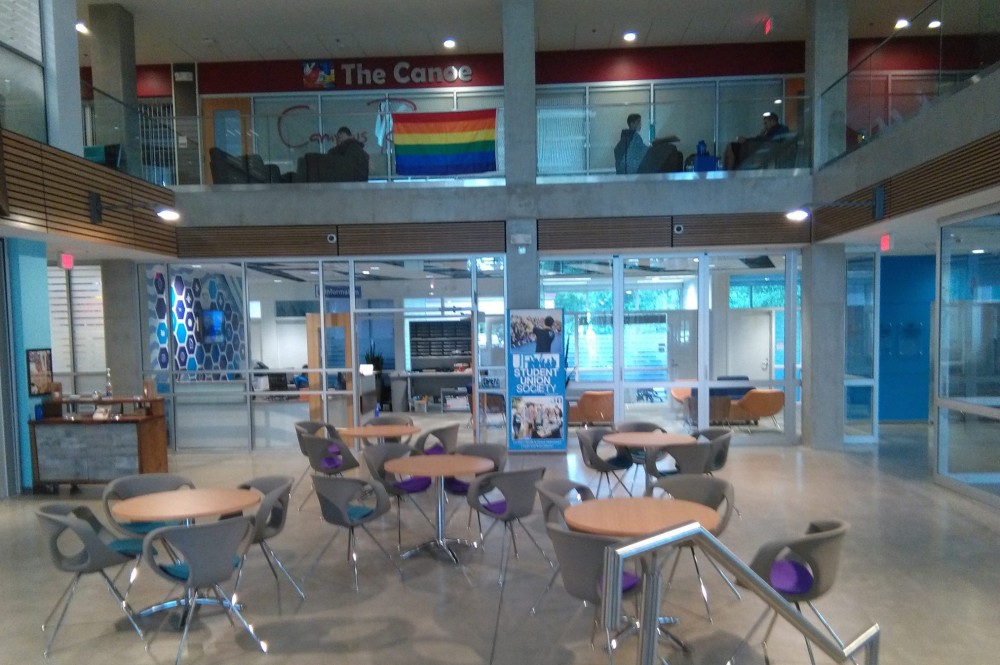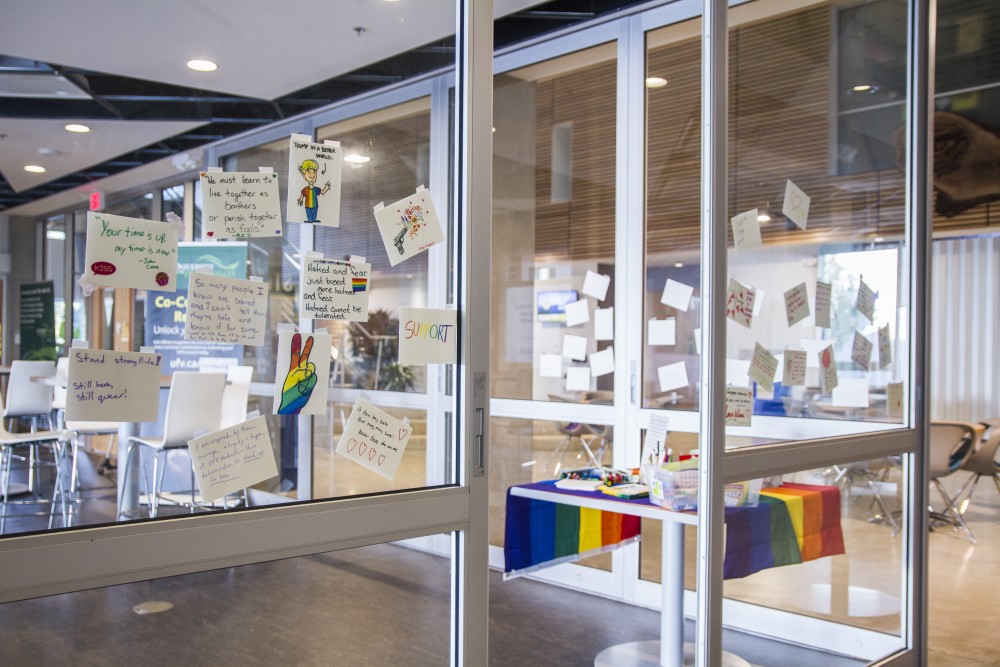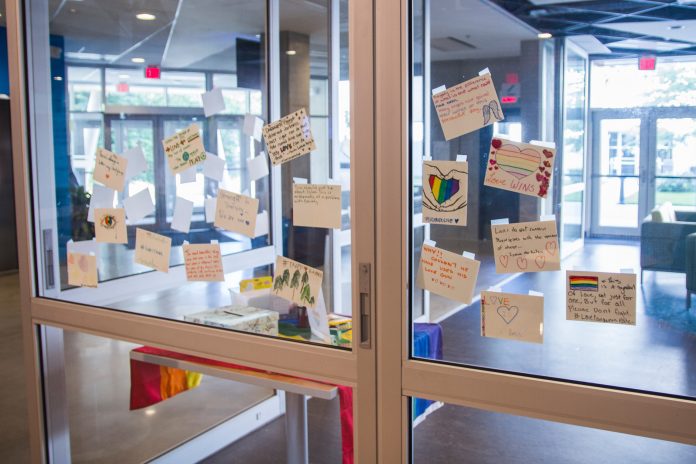By Michael Scoular (The Cascade) – Email
The confluence of international tragedy and events at UFV — beginning with the removal of a pride flag hung following the Orlando Pulse shooting of two weeks ago — has opened up questions of how to mend relations between UFV’s Pride Collective group and the Student Union Society (SUS), which have grown increasingly strained over the past year.
“It feels like constant tension,” says Sean Evans, a member of the collective. “Nobody has the whole story — I’ve heard rumours, but nothing was ever said to me.”
Evans is referring to the flag-hanging, but also to other separate events that together point to, at best, a fixable breakdown in communication, and at worst, a cultural opposition to seeing a supported, flourishing queer community.
In this respect, UFV would hardly be alone. Canadian headlines from the past week bear this out: in the Winnipeg area, MP Ted Falk announced he would decline an invitation to a pride parade on principle: “I’ve been clear on this issue many times, and have made my position public on my values of faith, family, and community,” he said in a statement. In Toronto, city mayor John Tory, also talking about a pride parade, said that the group organizing it “should be careful not to become too political” in an interview with the Toronto Star.
And so, when Sean Phillips, another member of the collective, along with Evans, decided to hang a pride flag on the second floor of the Student Union Building (SUB) the Monday after the murders in Orlando, he says he did so knowing that, in the Fraser Valley, to do so is to risk it being taken the wrong way.
Last year, after Abbotsford city hall raised the rainbow flag during annual pride events, city councillors immediately amended the flag-raising bylaw to close off the possibility of a repeat in response to residents, some of whom asserted that if one group could get its flag raised, all should be able to, sending petitions for other flags, including one saying “Straight Is Great” and three with variations on pro-life support.
“I was anxious,” Phillips says. In the office that the Pride Collective shares with three other student groups in the SUB, Phillips had hosted a peer support session for students who needed to talk in the early afternoon. (The university’s counselling department sent out an email the same day listing typical responses to hearing about trauma through the media, and extending an offer of emergency support.) Helping other students didn’t exempt Phillips from feeling, however, like he could do something more, and so he and Evans draped the flag over the railing just outside the restaurant on the second floor, visible to all on the main floor of the building.
“I tied it up with pipe cleaners,” he says — the railing wasn’t meant to hold up signs or flags. “It was not going to be up there for the night; it was going to be up there for a couple hours.”
Phillips expected that, if it had been left up longer, it might have been removed by security or janitorial staff after the building closed for the day. Both Phillips and Evans were unfamiliar with building protocol; all they knew was that, aside from a single day when the UFV flagpole raised a pride flag in solidarity with UBC following a flag-burning there, there has not been a pride flag on public display since renovations in A building one year ago. (The flag, which used to hang on the wall of an open study area, is gone; a glass-sealed display for LGBT students remains.)
Phillips and Evans next went down one floor to the SUS office where they spoke with Michael Chutskoff, the equalities officer. According to Phillips and Evans, the conversation was uneventful: some nervous small-talk, a joke about the clear symbolism and possible controversy of raising the flag in Abbotsford, and a note that, if the flag was taken down for any reason, Phillips would be in the office upstairs.
But from Chutskoff’s perspective, the meeting was not amicable. It was unscheduled, the joke was not taken as just a joke, and, while he would need to double-check the building’s policies, Chutskoff claims to have informed Phillips and Evans that the flag would likely be taken down. Chutskoff brought the matter to the SUS executive team (Sukhi Brar, the president, and Ashmeet Kaur and Thanh Ma, the vice-presidents) and, after deliberation, the decision was made to remove the flag according to a policy that states that, if something is considered an alteration or decoration to the building, it first needs to go through SUS as a formal request.
“I didn’t think that they would be the ones to take down a pride flag two days after the tragedy,” Phillips says. “I never thought the organization purporting themselves to be an ally would have taken it down according to a building policy.”
Brar says that, one month into her year-long term as president, the decision, informed by the adversarial relationship between SUS and the Pride Collective over the past year, was a mistake.
“I asked, ‘What’s the process on this?’ And we reverted to process,” she says. “Any kind of installation in our building, that’s going to go to the SUB committee, which [meets] next month. Was that the wrong call? Yeah that was the wrong call.”

But at the time, the flag removal was immediately perceived as a political act — it appeared that either the main body of student representation on campus was completely unaware of how their actions would be perceived, or, at a sensitive time, that they were holding policies in higher esteem, no matter the response from one of UFV’s most vocal student groups.
Phillips posted about the removal online, and students began to comment on the SUS’s Facebook page, asking why the flag was removed, shocked that, in contrast to their avatar (changed to a rainbow background in response to the shooting), the organization appeared to not support what students were going through.
The SUS response — all comments that weren’t informing students about counselling services were deleted immediately — added to the idea that the “support” was just for show. Both groups followed with statements, attempting to explain and shape the narrative of events. The SUS one, posted hours after the deletion began, framed the comments as trying to incite conflict. One line, adding that all comments would be deleted because they were not in keeping with “the focus or intent of the original post,” was edited out five minutes after the post went live.
“Our comments weren’t even being considered, but deleted automatically,” says Liz Laan, a member of the collective, who adds that some members were banned after multiple comments. “It was very frustrating, because so often it feels like we’re not even heard by SUS … It feels like they want to help and they want to make resources, but if you don’t listen or try to help out the people you’re purporting to help, then what’s the point?”
Brar says this series of mistakes is clear, and that she is working to make sure they aren’t repeated. The following week, bans were reversed (deleted comments on Facebook, however, cannot be restored).
“I wish I had thought this through [then],” she says. “A better approach, I think, would be to say: we messed up here, in this way, this is how we ended up in this situation.”
That situation — lack of trust for institutions, finding similarities in personal interactions and broader cultural pushback — was never going to be recuperated in the short term. But Martin Kelly, the student engagement coordinator at Student Life, decided to provide a venue for students: a table with pens where comments and illustrations in response to the Orlando killings could be posted on one of the SUB’s many glass surfaces.
“After the flag was removed, I brought up at a Student Life staff meeting the following day that, in response to student need, we should do something,” Kelly says. “Staff agreed we needed a space for students to put out their thoughts and feelings on what happened — there was clearly an emotional outburst from students that needed a place to go.”
The university also hosted a vigil the following week, where faculty, students, and president Mark Evered shared personal stories, memories, and thoughts summoned up by the news of the attack in Orlando.
Addressing a crisis is something that students clearly appreciate, but the question for the LGBT community is: how does that translate into long-term support? Multiple attendants at the vigil brought this up. Evans says it doesn’t have to be a convoluted or enormous dilemma.
“It’s not that I want gestures,” he says. “Martin Kelly has, as a queer student, been one of my most steadfast allies on campus. So it doesn’t just feel like a ‘gesture’ from him.”
The term “allies” is one that comes with a particular definition as it relates to activism, but what Evans describes is fairly simple: someone who listens, works to help others based on what they learn from listening, and is honest about where they’re coming from, what they don’t know, and what they’re willing to do about it.

Speaking at a Pride Collective meeting last Friday, the first following the flag removal, Charlie Steele, a former coordinator of the collective, said that, in this situation, what could have resolved the issue was immediate face-to-face conversations. After the flag was removed, Chutskoff sent an email to the Pride Collective’s email, but both Evans and Phillips did not have access to that account — only the students who have title positions within the club do. Meanwhile, Phillips was waiting in the office upstairs, hoping that someone from SUS would come to talk. Downstairs, SUS employees were also willing to talk — but only through particular channels.
Steele, days before, announced they would be stepping down as coordinator, citing SUS’s “spiteful attitude” and “oppressive methods of governance.” An apology letter, written by Brar, which closed with an offer of mediation through a third party (yet to be named), was apparently not enough to indicate that a working relationship between SUS and the Pride Collective would likely improve. (Like all student groups on campus, Pride is required to register with SUS in order to receive official status, the ability to book rooms, and funding.)
“I’m honestly not surprised at all,” Laan says, reacting to Steele’s decision. “There’s way too many Pride execs and members who are hitting burnout because they just can’t deal [with SUS].”
Laan, like most people connected to either group, speaks with the knowledge that the flag removal was preceded by two significant decisions in the past year which developed with a similar pattern — an action, a breakdown in communication, and both sides unsatisfied.
While the vigil at UFV was held at U-House, the Chronicle of Higher Education reports that, at many universities, LGBT centres on campus provided support, organized events, and were a site for students to meet. The office space Pride currently has at UFV is subject to rotation — only eight out of 75 groups are approved, based on an application system, each year.
The Equalities Resource Centre (ERC), which was petitioned by several student groups a year ago, then subsequently developed by SUS, then passed over in favour of another proposal (for a health centre), in theory could have served a similar purpose.
“A mistake on our part was not communicating what was going on,” Brar says, looking back on the ERC, which was mostly discussed in a closed committee. “A lot of people felt left out of the process.”
Today, Pride Collective members mostly refer to it as a “debacle,” an example of an inability for SUS to translate student need into a cohesive arrangement, but also for student groups to come together under a common understanding. While students close to the committee know where discussion broke down, no detailed explanation was made at the time. Students from the LGBT community, but not part of the Pride Collective, questioned whether the collective’s idea of the ERC could possibly be representative of students outside of that group’s circle, the Pride Collective questioned why the SUS took up a petition that was intended for UFV, and, in the end, no one got what they wanted.
And more recently, because of a paperwork error for a concert organized by the Pride Collective, the group was banned from holding events on campus for one year by SUS, and for six months by the university — however, following an appeal by the group, the error was found to be shared between all three groups involved. UFV lifted its ban; the SUS appeal is still in progress with an unknown resolution date.
For Brar, there’s a lot of history to reflect on. The Pride Collective, at their meeting last week, noted that, regardless of who was right or wrong, some people still perceive the group as unwelcoming and confrontational. Both sides independently recognize there’s work to do.
“Looking back, the major lesson I’ve learned is: I’m going be forthcoming about where I mess up,” Brar says. “There’s all kinds of conversations that need to happen.”
“I have been considering finishing my degree elsewhere,” Evans says. “There’s a couple profs out there who are good to talk to, but again, the support is really limited. It’s not in a great situation now. We have to try to make it better, but we can’t have any illusions about it being a great situation right now.”
A preliminary idea of how to improve relations was noted at the Pride Collective meeting: Steele told members that, after a long discussion with Brar, a proposal is in the works “to give Pride a permanent, self-governed space in the SUB.”
“It almost sounds too good to be true,” said Kyle Stamm, one of the students at the meeting. Most agreed that the space — which would potentially be on the second floor of the building beside the current offices for student groups — would be an ideal fit, but that until it happens, it is hard to know how much hope they can put into the idea.
The full proposal will be presented by Brar at the next Pride Collective meeting on June 30 (6:00 p.m.). Depending on the outcome of that meeting, it could then go before the SUS board in July.
With files from Glen Ess.


